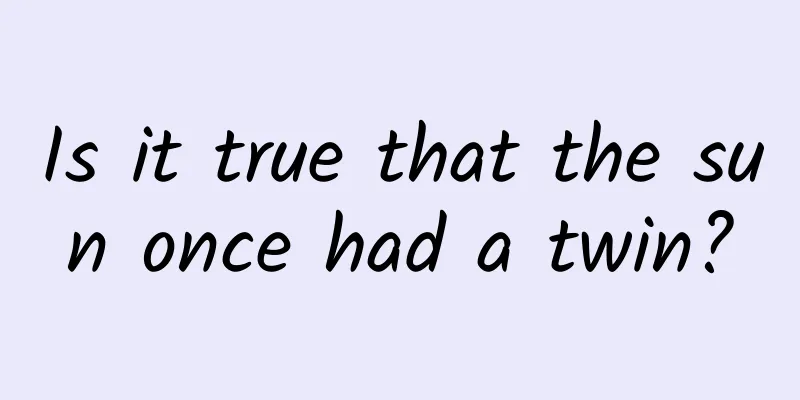Is it true that the sun once had a twin?

|
The Sun is the only star in our solar system, but it may not have been like this from the beginning. Some astronomers believe that in the distant beginning, the Sun may have had a brother: a companion star. It is not uncommon for stars in the universe to have a companion star. According to observations, more than half of all known stars similar to the sun have a companion star. The first thing that gave astronomers this idea was an unknown planet hidden in the Oort Cloud, which some people called "Planet Nine". As we all know, after Pluto was kicked out of the planetary queue, there were only eight planets left in the solar system. Where did Planet Nine come from? This has to start with Neptune. When scientists studied Neptune's orbit, they found that there was a large deviation between its actual trajectory and the theoretical trajectory, and this deviation was not unique to Neptune. The orbits of several dwarf planets around it also had the same problem. What causes this deviation? There is a simple and very reasonable explanation, that is, there is a massive celestial body hidden in the Oort Cloud near Neptune. It is a planet with a mass about 10 times that of the Earth. Because of the existence of this massive celestial body, Neptune and several nearby dwarf planets were affected by its gravity, causing deviations in their orbits. This imaginary massive celestial body is called "Unknown Planet Nine." The hypothesis of Planet Nine is a good answer to the question of Neptune's orbital deviation, but it also brings up a new question: If Planet Nine exists, why does it exist? The Oort Cloud, as the boundary of the solar system, is very far away from the Sun, about 2,000 to 100,000 AU. At such a long distance, the Sun's gravitational pull is already relatively weak. How could such a massive celestial body be captured and bound here? Whether Planet Nine exists and why it exists are unsolved mysteries, and the Oort Cloud itself also has many mysteries. First of all, the shape of the Oort Cloud does not match the shape of the solar system itself. The solar system is a typical disk-shaped structure, while the Oort Cloud is a diffuse sphere that tightly wraps the earth from all directions. This structure obviously does not conform to the known theory of galaxy formation. In addition, where do the celestial bodies in the Oort Cloud come from? Some of the celestial bodies in the Oort Cloud come from the solar system itself, which are some of the leftovers after the formation of the solar system, but their proportion will not exceed one-third at most, which means that most of the celestial bodies in the Oort Cloud were captured from the outside world. The Oort Cloud, especially its outer part, is 100,000 astronomical units away from the Sun. The Sun's weak gravity is simply not enough to attract so many celestial bodies here. So why do these small celestial bodies gather here? These mysteries are too difficult to explain, but if we make a bold assumption, all the mysteries will be solved, and that assumption is: the sun once had a companion star. If at the beginning of the formation of the sun, there was not one star but two, which orbited each other and formed a binary star system, then this system would have enough power to form a spherical nebula on the periphery. Whether it is a large number of small celestial bodies or a large mass celestial body like Planet Nine, they will be captured by the gravity of this binary star system, and because these celestial bodies come from all directions, they naturally form a spherical structure. Shortly after this, perhaps a massive wandering star passed by here, pulling the Sun's brother over with its strong gravity, and taking away some of the small celestial bodies in the Oort Cloud, making this spherical nebula become the sparse appearance it is now. Of course, all of this is just speculation, and perhaps in the future we will find that the real situation of the universe is more exciting than we imagined. |
<<: Why do I have to drive through a red light when I see one? It turns out it’s not just bad luck!
Recommend
C4D tutorial 105 episodes
This set of C4D example tutorials has a total of ...
Online event operation: How to make a "hot-selling micro-course"?
In this era of paid knowledge , whether you are a...
How will smart TVs change the future of home entertainment?
What is home entertainment? The elderly people bo...
How much does it cost to develop a Huizhou property app? What is the price for developing a Huizhou property app?
The factors that affect the quotation of Huizhou ...
The United States announced that it has begun to develop 6G. Is this leapfrog development reliable?
The US government has been concerned about losing...
Disappointing: Apple Watch's sapphire screen is so bad
The low production volume is only one of the reas...
Can the resource library of iOS 14 system be closed?
The iOS 14 system has added a new resource librar...
With R&D funding only half of its competitors, how much advantage can Ecovacs maintain after sliding from the blue ocean to the red ocean?
Since July, Ecovacs' stock price has been fal...
How much does it cost to develop a pregnancy and childbirth app in Pingliang?
Mini programs provide convenience for publicity a...
Compose-Multiplatform Practice on Android and iOS
01 Introduction We have previously discussed KMM,...
4 steps to complete Baidu information flow delivery! Home decoration case sharing~
The home improvement industry is a typical large ...
A must have! 18 hot spot tracking tools for marketing and promotion operators!
"Chasing hot topics" is a common practi...
It disappeared for 40 years and was named "extinct", but it recently reappeared!
In the past two weeks, we have collected these fr...
Seven-part training camp: A compulsory course for short video traffic monetization, gaining huge traffic through adaptation
This course has a total of 134 complete episodes....
Edge browser expands translation capabilities on Android platform
Following the screenshot feature, Microsoft conti...









